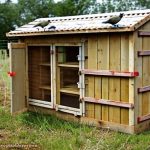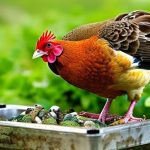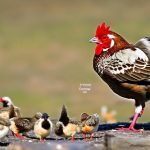Chickens are highly susceptible to heat stress, which can significantly impact their health and productivity. When temperatures rise, chickens may experience decreased feed intake, reduced egg production, and increased mortality rates. Heat stress can compromise their immune systems, making them more vulnerable to diseases and infections.
High temperatures can also lead to dehydration and heat stroke in chickens, further exacerbating health issues. Understanding the physiological responses of chickens to heat stress is crucial for poultry farmers to effectively mitigate its impact on their flocks. Heat stress in chickens often results in reduced feed intake, leading to slower growth rates and poor weight gain, which ultimately affects overall flock productivity.
In laying hens, heat stress can cause a decline in egg production and quality, as well as an increase in soft-shelled or misshapen eggs. Additionally, heat stress can negatively impact egg fertility and hatchability, resulting in economic losses for poultry farmers. Recognizing the signs of heat stress in chickens and implementing proactive measures to mitigate its effects are essential for maintaining flock health and productivity.
Table of Contents
- 1 Providing shade and shelter for chickens
- 2 Ensuring access to cool, fresh water
- 3 Using fans and misters to lower temperatures
- 4 Adjusting feeding schedules and types of feed
- 5 Monitoring and managing heat stress in chickens
- 6 Implementing emergency measures for extreme heat conditions
- 7 FAQs
- 7.1 What are the signs of heat stress in chickens?
- 7.2 How can I keep my chickens cool during a heat wave?
- 7.3 What are some ways to provide shade for chickens?
- 7.4 How often should I change my chickens’ water during a heat wave?
- 7.5 Can I give my chickens ice to help keep them cool?
- 7.6 Should I adjust my chickens’ feeding schedule during a heat wave?
Key Takeaways
- Heat stress can have a significant impact on chickens, leading to decreased egg production, poor growth, and even death.
- Providing shade and shelter is crucial for chickens to escape the direct heat of the sun and reduce the risk of heat stress.
- Access to cool, fresh water is essential for chickens to stay hydrated and regulate their body temperature during hot weather.
- Using fans and misters can help lower temperatures in chicken coops and provide relief from extreme heat.
- Adjusting feeding schedules and types of feed can help reduce heat production in chickens and support their overall health during hot weather.
- Monitoring and managing heat stress in chickens is important to identify early signs and take necessary actions to prevent serious health issues.
- Implementing emergency measures, such as wetting the ground or providing ice packs, can help chickens cope with extreme heat conditions and prevent heat-related illnesses.
Providing shade and shelter for chickens
Constructing Well-Ventilated Chicken Coops
One of the most effective ways to mitigate the impact of heat on chickens is by providing adequate shade and shelter. This can be achieved by constructing well-ventilated chicken coops with proper insulation to help regulate the internal temperature. Additionally, providing access to shaded areas within the outdoor space where chickens are allowed to roam can help them find relief from the heat.
Creating Cool Areas for Chickens
Natural shade from trees or artificial shade structures can be used to create cool areas for chickens to rest and seek refuge from the sun. It is important to ensure that the shade is accessible throughout the day as the position of the sun changes.
Ensuring Proper Ventilation
In addition to providing shade, it is essential to ensure proper ventilation within the chicken coop to allow for air circulation and heat dissipation. This can be achieved by installing windows, vents, or fans to facilitate airflow and reduce the buildup of heat inside the coop. Adequate ventilation is crucial in preventing heat stress in chickens and maintaining a comfortable environment for them to thrive.
By providing shade and shelter, poultry farmers can help their chickens cope with high temperatures and minimize the negative impact of heat stress on their health and productivity.
Ensuring access to cool, fresh water

Access to cool, fresh water is essential for chickens to stay hydrated and regulate their body temperature during hot weather. Poultry farmers should ensure that water is readily available to their flocks at all times, especially during periods of high temperatures. It is important to regularly check water sources to ensure that they are clean and free from contaminants that could compromise the health of the chickens.
Additionally, water should be kept cool by using shaded containers or adding ice to prevent it from becoming too warm for consumption. In order to encourage water consumption, it is beneficial to provide multiple water stations throughout the chicken coop and outdoor areas. This ensures that all chickens have easy access to water and reduces competition for drinking space.
Poultry farmers should also consider using automatic watering systems that provide a continuous supply of fresh water to their flocks. By ensuring access to cool, fresh water, farmers can help chickens stay hydrated and maintain their body temperature within a healthy range, reducing the risk of heat stress and its negative effects on their health.
Using fans and misters to lower temperatures
Fans and misters can be effective tools for lowering temperatures and reducing heat stress in chicken coops and outdoor areas. Fans help circulate air and create a cooling effect, while misters spray fine droplets of water into the air, which evaporate and lower the ambient temperature. By strategically placing fans and misters in chicken coops and shaded outdoor areas, poultry farmers can create a more comfortable environment for their flocks during hot weather.
Fans should be positioned to provide adequate airflow throughout the chicken coop, ensuring that all areas are well-ventilated. Misters can be installed in outdoor areas where chickens congregate, such as feeding and resting areas, to provide relief from the heat. It is important to monitor the effectiveness of fans and misters in lowering temperatures and adjust their placement as needed to maximize their impact.
By using fans and misters, poultry farmers can help their chickens cope with high temperatures and reduce the risk of heat stress, ultimately maintaining their health and productivity.
Adjusting feeding schedules and types of feed
During periods of high temperatures, it is beneficial to adjust feeding schedules and types of feed to help chickens cope with heat stress. Feeding chickens during the cooler parts of the day, such as early morning or late evening, can help reduce the impact of heat on their metabolism and digestion. This allows chickens to consume feed when they are more likely to eat, minimizing the negative effects of reduced feed intake during hot weather.
In addition to adjusting feeding schedules, poultry farmers can consider using feed additives or supplements that help chickens cope with heat stress. These may include electrolytes or probiotics that support hydration and gut health, as well as feed formulations with lower protein content to reduce metabolic heat production. It is important to consult with a poultry nutritionist or veterinarian to determine the most appropriate feed options for chickens during periods of high temperatures.
By adjusting feeding schedules and types of feed, farmers can help their flocks maintain their nutritional needs and minimize the impact of heat stress on their health and productivity.
Monitoring and managing heat stress in chickens

Recognizing the Signs of Heat Stress
Common signs of heat stress in chickens include panting, wing spreading, reduced activity, decreased feed intake, and increased water consumption. Poultry farmers should regularly observe their flocks for these signs and take proactive measures to mitigate the effects of heat stress.
Monitoring Environmental Conditions
In addition to visual observation, it is beneficial to monitor environmental conditions within the chicken coop and outdoor areas using thermometers or temperature sensors. This allows farmers to track changes in temperature and humidity levels, enabling them to make informed decisions about implementing measures to reduce heat stress.
Effective Management of Heat Stress
By monitoring the signs of heat stress and environmental conditions, poultry farmers can effectively manage its impact on their flocks and take proactive steps to maintain their health and productivity.
Implementing emergency measures for extreme heat conditions
In extreme heat conditions, it may be necessary to implement emergency measures to protect chickens from the negative effects of heat stress. This may include temporarily relocating chickens to cooler areas with better ventilation and shade, such as a well-ventilated barn or shaded structure. Poultry farmers should also consider using emergency cooling methods, such as wetting the ground with water or using portable misting systems, to create a cooler environment for their flocks.
It is important to closely monitor chickens during extreme heat conditions and be prepared to provide additional support as needed. This may include offering electrolyte supplements in water, providing access to cool baths or misting stations, or even seeking veterinary care for severely affected individuals. By implementing emergency measures for extreme heat conditions, poultry farmers can help protect their flocks from the potentially devastating effects of heat stress and ensure their health and well-being during challenging weather conditions.
In conclusion, understanding the impact of heat on chickens is crucial for poultry farmers to effectively mitigate its negative effects on their health and productivity. By providing shade and shelter, ensuring access to cool, fresh water, using fans and misters, adjusting feeding schedules and types of feed, monitoring and managing heat stress, and implementing emergency measures for extreme heat conditions, farmers can help their flocks cope with high temperatures and maintain their well-being. It is important for poultry farmers to be proactive in addressing heat stress in chickens in order to ensure their health and productivity even during challenging weather conditions.
If you’re looking for tips on how to keep chickens cool during a heat wave, you might also be interested in learning about the best chicken coop for hot climates. Check out this article on poultrywizard.com for more information on how to provide the best environment for your chickens during hot weather.
FAQs
What are the signs of heat stress in chickens?
Some signs of heat stress in chickens include panting, holding their wings away from their bodies, decreased egg production, and lethargy.
How can I keep my chickens cool during a heat wave?
You can keep your chickens cool during a heat wave by providing plenty of shade, ensuring they have access to fresh, cool water at all times, and using fans or misters to lower the temperature in their coop.
What are some ways to provide shade for chickens?
You can provide shade for your chickens by using tarps, umbrellas, or natural shade from trees or shrubs. It’s important to make sure the shade is well-ventilated to allow for air flow.
How often should I change my chickens’ water during a heat wave?
During a heat wave, it’s important to change your chickens’ water at least twice a day to ensure it stays cool and fresh.
Can I give my chickens ice to help keep them cool?
Yes, you can give your chickens ice to help keep them cool. You can add ice to their water or place ice packs in their coop to provide additional cooling.
Should I adjust my chickens’ feeding schedule during a heat wave?
It’s a good idea to adjust your chickens’ feeding schedule during a heat wave. Feeding them in the early morning or late evening when it’s cooler can help reduce the heat stress on their bodies.
Meet Walter, the feathered-friend fanatic of Florida! Nestled in the sunshine state, Walter struts through life with his feathered companions, clucking his way to happiness. With a coop that’s fancier than a five-star hotel, he’s the Don Juan of the chicken world. When he’s not teaching his hens to do the cha-cha, you’ll find him in a heated debate with his prized rooster, Sir Clucks-a-Lot. Walter’s poultry passion is no yolk; he’s the sunny-side-up guy you never knew you needed in your flock of friends!







